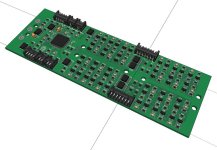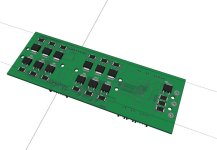2moto
100 W
Well, this will be my first post to hopefully make a decent contribution to ES. After having looked around pretty exhaustively (at least I hope so) for a suitable BMS, I came across one designed by Walls99. His BMS thread can be found here: http://www.gopednation.com/forum/showthread.php?t=302422. So, firstly, full credit goes to him for the design of this BMS.
Why did I choose this one?
1. It's pretty simple
2. Has the features I needed: cell balancing, low voltage monitor on each cell, doesn't interfere with motor power circuit, modular, easily adapted to other cell chemistries.
3. Requires only simple mains power supply.
4. It's proven to work and over a year's worth of use.
Many thanks to Wall99 who was kind enough to very patiently answer all my questions and provide the Eagle PCB files as well as PIC source code. He also reviewed my changes and corrected a few errors. I won't hold it against him that he uses assembler language! :lol:
I've made a number of changes to his design in order to make it work for my configurations. I use mainly LiPo packs of either 10s or 12s.
My changes:
1. Changed the cell low voltage monitor and cell balance monitor circuits to LiPo. LV is 3.1V and HV is 4.2V.
2. Increased number of cells to 12S. This could easily be increased even further. Each cell circuit is floating and modular per cell and uses one additional input pin on the microcontroller.
3. Changed the charging circuit to a maximum current ot 10A.
4. Increased cell balancing current to 1A with multiple cell balancing.
5. Added temperature sensors (up to 4) for measuring cell pack temperature. I tend to build my batteries in packs of 4, so for a 10s pack I use 4 packs of 5s in a 2 parallel/2 series configuration. Having temperature sensing in a LiPo battery is a must in my book.
6. Changed to microcontroller to a PIC24, mainly so I can use C instead of assembler and have some head room for future features such as a "fuel gauge", etc.
Below are the revised schematics and 3d board assembly. The board layout 3D model is a Sketchup model so can used in mechanical assembly drawings. The board measures 140 by 48 mm, so slightly smaller footprint than a modern smart phone. I wish Eagle PCB could export directly to SolidWorks!
All things being well, it should be up and running by Christmas. PCB is being made now. Software is progressing (time permitting). Let me know if you have any questions or suggestions.
View attachment 3
View attachment 2


Why did I choose this one?
1. It's pretty simple
2. Has the features I needed: cell balancing, low voltage monitor on each cell, doesn't interfere with motor power circuit, modular, easily adapted to other cell chemistries.
3. Requires only simple mains power supply.
4. It's proven to work and over a year's worth of use.
Many thanks to Wall99 who was kind enough to very patiently answer all my questions and provide the Eagle PCB files as well as PIC source code. He also reviewed my changes and corrected a few errors. I won't hold it against him that he uses assembler language! :lol:
I've made a number of changes to his design in order to make it work for my configurations. I use mainly LiPo packs of either 10s or 12s.
My changes:
1. Changed the cell low voltage monitor and cell balance monitor circuits to LiPo. LV is 3.1V and HV is 4.2V.
2. Increased number of cells to 12S. This could easily be increased even further. Each cell circuit is floating and modular per cell and uses one additional input pin on the microcontroller.
3. Changed the charging circuit to a maximum current ot 10A.
4. Increased cell balancing current to 1A with multiple cell balancing.
5. Added temperature sensors (up to 4) for measuring cell pack temperature. I tend to build my batteries in packs of 4, so for a 10s pack I use 4 packs of 5s in a 2 parallel/2 series configuration. Having temperature sensing in a LiPo battery is a must in my book.
6. Changed to microcontroller to a PIC24, mainly so I can use C instead of assembler and have some head room for future features such as a "fuel gauge", etc.
Below are the revised schematics and 3d board assembly. The board layout 3D model is a Sketchup model so can used in mechanical assembly drawings. The board measures 140 by 48 mm, so slightly smaller footprint than a modern smart phone. I wish Eagle PCB could export directly to SolidWorks!
All things being well, it should be up and running by Christmas. PCB is being made now. Software is progressing (time permitting). Let me know if you have any questions or suggestions.
View attachment 3
View attachment 2





